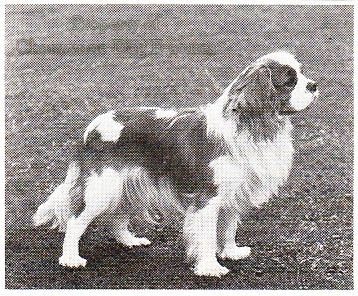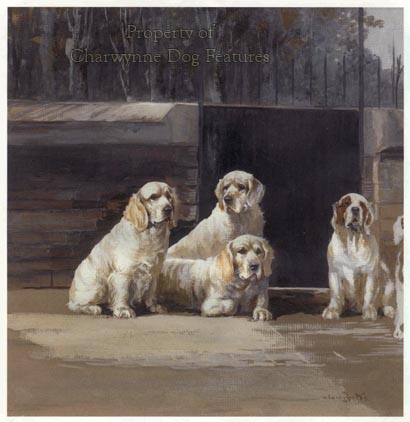536 Harming dogs by Design
HARMING DOGS -BY DESIGN
by David Hancock

 Eighty years ago, an American dog-lover, Roswell Eldridge, was perturbed enough, when visiting England, on seeing what English fanciers had done to the King Charles spaniel, to decide, instead of just walking away, to do something about it. Prizes were to be offered prizes every year for five years at Crufts Dog Show for: "The best dog and the best bitch exhibited in a class for Blenheim Spaniels of the old type, as shown in the pictures of Charles II's time: long face, no stop, flat skull, not inclined to be 'domed' --with spot on centre of skull." He had been appalled by the flat-nosed, almost muzzleless monstrosities, usually also featuring protruding runny eyes and misshapen skulls, masquerading as King Charles spaniels in the British show rings. Some of the more enlightened breeders responded and in due course the longer nosed Cavalier King Charles spaniel was registered and the public have since demonstrated their views: in 2006 there were 11,400 registrations of Cavaliers and only 250 of the squashed faced kind, the King Charles. A public response.
Eighty years ago, an American dog-lover, Roswell Eldridge, was perturbed enough, when visiting England, on seeing what English fanciers had done to the King Charles spaniel, to decide, instead of just walking away, to do something about it. Prizes were to be offered prizes every year for five years at Crufts Dog Show for: "The best dog and the best bitch exhibited in a class for Blenheim Spaniels of the old type, as shown in the pictures of Charles II's time: long face, no stop, flat skull, not inclined to be 'domed' --with spot on centre of skull." He had been appalled by the flat-nosed, almost muzzleless monstrosities, usually also featuring protruding runny eyes and misshapen skulls, masquerading as King Charles spaniels in the British show rings. Some of the more enlightened breeders responded and in due course the longer nosed Cavalier King Charles spaniel was registered and the public have since demonstrated their views: in 2006 there were 11,400 registrations of Cavaliers and only 250 of the squashed faced kind, the King Charles. A public response.
Apart from the shame of it having to take an overseas visitor to show us the error of our ways, this is a most encouraging story for those who believe that there are around twenty registered breeds of pedigree dog which would undoubtedly gain from such a visionary benefactor today. The general public are given the very definite impression at shows such as Crufts that purebred dogs are being firstly perpetuated in the mould of their ancestors and secondly bred healthily and soundly. If only it were true. Far too many of our native breeds and those we have elected to import are being bred to a design quite unlike that desired in the early specimens. They are so often being promoted by contemporary fanciers with little concept of how function decided form and indeed what their breed used to look like. 
British dog breeders are sometimes accused of placing 'type' , i.e. those physical attributes which make a breed of dog identifiable from other breeds, ahead of soundness. I believe however that many are guilty of something much more reprehensible: the harmful exaggeration of type. This has been variously attributed to: the personal whim of one wealthy influential breeder, a dominant clique in a breed club, an uncharacteristic trait appearing in a breed which is easier to claim falsely as typical than to breed out and a misplaced desire to 'improve' a breed according to contemporary criteria. 
In such a way, has the Bull Terrier been given piggy eyes and a ruggerball for a head, the German shepherd dog made to look like a black and tan hyena, the Mastiff made into a fawn Alpine Mastiff, the Scottish Terrier given the appearance of an animated hovercraft and the Bulldog an anatomy which defies nature in every limb. The explanations given by breeders for such irrational and often irresponsible behaviour range from the bizarre to the foolish, but are never convincing. Why do we need to inflict handicaps on breeds skilfully developed by master breeders in more informed times, breeds admired allover the world for what they were? The thoroughbred horse has, after all, remained the same in appearance down the centuries. 
Why does an Irish Wolfhound need legs like tree trunks when the Russian Wolfhound has legs more like a Deerhound for the same function? In big breeds, it starts I suspect, with the absurd quest for 'great bone' , something our ancestors learned not to prize. This quest has led to the St Bernard now being quite unsuitable as a mountain rescue dog, the Mastiff becoming prized mainly for its size and even the Clumber Spaniel, initially developed as a 40lb sporting dog, now actually being required to be twice that weight in its breed standard. The admirable enthusiasts now striving to revive the working instincts of this distinguished sporting breed use dogs weighing nearer 40lbs. Why breed a dog away from its intended function? Functional merit should always prevail over fashion and human whim. Breeds still remitting to a declared function remain unexaggerated; loss of function leads to loss of form. Breeds with profuse coats are much loved on the show circuit. The Shetland Sheepdog, originally just a smaller working sheepdog, now resembles a large Pomeranian with a lowered tail. The American Cocker Spaniel, still classified by the Kennel Club as a gundog, is rapidly becoming a heavily-skirted dome-headed coat-handicapped ornament. The Afghan Hound, once a noble sighthound, is now taken to shows wearing a shell-suit and bootees, because the dog's coat is considered more important than the dog's dignity. The coursing hounds are proud dogs; I hate seeing them humiliated in this way. A Bulldog which cannot breathe freely, a Mastiff so heavy it cannot run with ease, a Basset Hound crippled with arthritis or a Dachshund with the pain of a slipped disc tell you a great deal about us; they truly deserve more caring human custodianship.